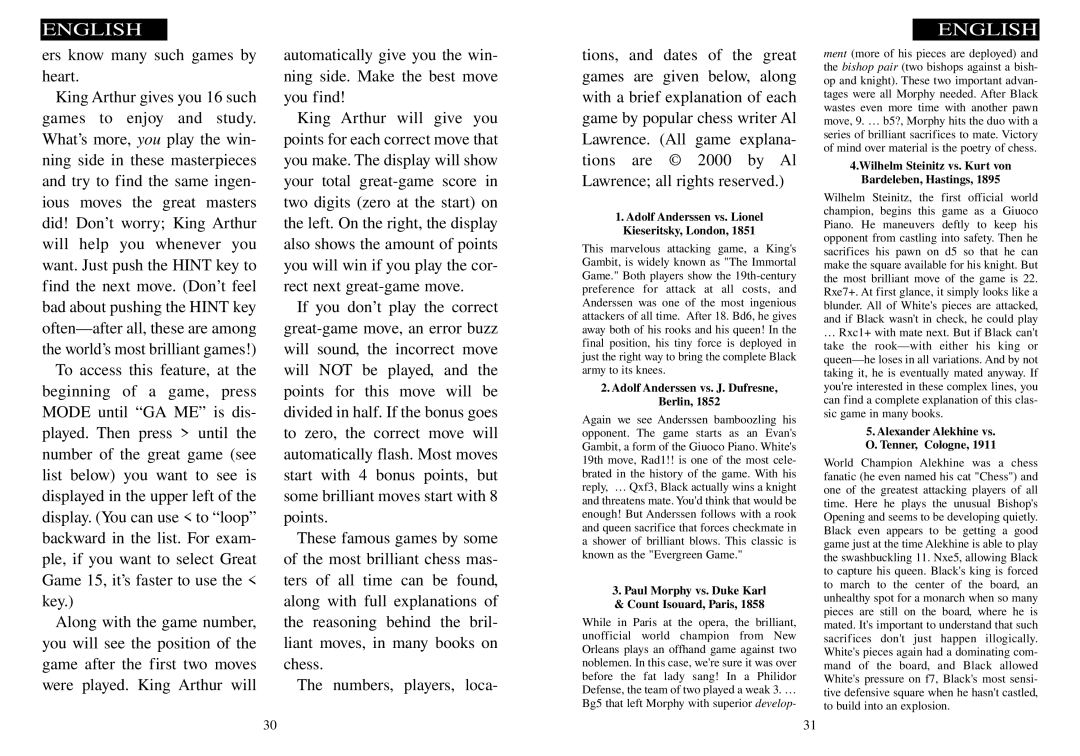ENGLISH
ers know many such games by heart.
King Arthur gives you 16 such games to enjoy and study. What’s more, you play the win- ning side in these masterpieces and try to find the same ingen- ious moves the great masters did! Don’t worry; King Arthur will help you whenever you want. Just push the HINT key to find the next move. (Don’t feel bad about pushing the HINT key
To access this feature, at the beginning of a game, press MODE until “GA ME” is dis- played. Then press > until the number of the great game (see list below) you want to see is displayed in the upper left of the display. (You can use < to “loop” backward in the list. For exam- ple, if you want to select Great Game 15, it’s faster to use the < key.)
Along with the game number, you will see the position of the game after the first two moves were played. King Arthur will
automatically give you the win- ning side. Make the best move you find!
King Arthur will give you points for each correct move that you make. The display will show your total
If you don’t play the correct
These famous games by some of the most brilliant chess mas- ters of all time can be found, along with full explanations of the reasoning behind the bril- liant moves, in many books on chess.
The numbers, players, loca-
tions, and dates of the great games are given below, along with a brief explanation of each game by popular chess writer Al Lawrence. (All game explana- tions are © 2000 by Al Lawrence; all rights reserved.)
1.Adolf Anderssen vs. Lionel Kieseritsky, London, 1851
This marvelous attacking game, a King's Gambit, is widely known as "The Immortal Game." Both players show the
2.Adolf Anderssen vs. J. Dufresne, Berlin, 1852
Again we see Anderssen bamboozling his opponent. The game starts as an Evan's Gambit, a form of the Giuoco Piano. White's 19th move, Rad1!! is one of the most cele- brated in the history of the game. With his reply, … Qxf3, Black actually wins a knight and threatens mate. You'd think that would be enough! But Anderssen follows with a rook and queen sacrifice that forces checkmate in a shower of brilliant blows. This classic is known as the "Evergreen Game."
3.Paul Morphy vs. Duke Karl
&Count Isouard, Paris, 1858
While in Paris at the opera, the brilliant, unofficial world champion from New Orleans plays an offhand game against two noblemen. In this case, we're sure it was over before the fat lady sang! In a Philidor Defense, the team of two played a weak 3. … Bg5 that left Morphy with superior develop-
ENGLISH
ment (more of his pieces are deployed) and the bishop pair (two bishops against a bish- op and knight). These two important advan- tages were all Morphy needed. After Black wastes even more time with another pawn move, 9. … b5?, Morphy hits the duo with a series of brilliant sacrifices to mate. Victory of mind over material is the poetry of chess.
4.Wilhelm Steinitz vs. Kurt von
Bardeleben, Hastings, 1895
Wilhelm Steinitz, the first official world champion, begins this game as a Giuoco Piano. He maneuvers deftly to keep his opponent from castling into safety. Then he sacrifices his pawn on d5 so that he can make the square available for his knight. But the most brilliant move of the game is 22. Rxe7+. At first glance, it simply looks like a blunder. All of White's pieces are attacked, and if Black wasn't in check, he could play
…Rxc1+ with mate next. But if Black can't take the
5.Alexander Alekhine vs. O. Tenner, Cologne, 1911
World Champion Alekhine was a chess fanatic (he even named his cat "Chess") and one of the greatest attacking players of all time. Here he plays the unusual Bishop's Opening and seems to be developing quietly. Black even appears to be getting a good game just at the time Alekhine is able to play the swashbuckling 11. Nxe5, allowing Black to capture his queen. Black's king is forced to march to the center of the board, an unhealthy spot for a monarch when so many pieces are still on the board, where he is mated. It's important to understand that such sacrifices don't just happen illogically. White's pieces again had a dominating com- mand of the board, and Black allowed White's pressure on f7, Black's most sensi- tive defensive square when he hasn't castled, to build into an explosion.
30 | 31 |
